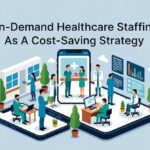Imagine a healthcare system where doctors can predict and prevent illnesses before they become severe. This is not science fiction but a reality brought to life. So, what makes this possible? It’s the incredible force of data. That’s correct!
Gone are the days when medical decisions were solely based on intuition and experience. Today, healthcare providers are leveraging the vast amounts of data generated within the healthcare system. This data has let them make informed decisions to improve patient outcomes.
In this blog post, we will take a closer look at how data-driven approaches are revolutionizing the healthcare landscape.
Electronic Health Records
Electronic Health Records are digital versions of a patient’s medical history, treatment plans, test results, and more. Due to their numerous advantages, they have replaced traditional paper-based records in most healthcare settings.
One of the primary benefits of EHRs is accessibility. When a patient’s medical information is stored electronically, it can be quickly retrieved by authorized healthcare professionals during emergencies. As a result, it helps improve the speed and accuracy of diagnosis and treatment.
But remember, managing patient data effectively is fundamental to healthcare delivery. For this, having a Data Governance Framework is crucial. It is a set of policies, procedures, and standards that ensure data quality, security, and compliance. In the context of EHRs, it helps maintain the integrity and privacy of patient information.
Predictive Analytics for Early Intervention
Predictive analytics in healthcare is like having a crystal ball that can help foresee health risks before they become serious. It’s a powerful tool that enables doctors to take proactive measures, resulting in improved patient outcomes.
One of the key benefits of predictive analytics is its ability to identify health risks and early signs of illness. By analyzing large datasets of patient information, predictive models can detect patterns that might be missed by human observation alone.
For example, these models can identify individuals who are at a higher risk of developing conditions like diabetes or heart disease based on their lifestyle, genetics, and health history.
Another significant advantage of predictive analytics is its role in reducing hospital readmissions. By tailoring post-discharge care plans to individual needs, hospitals can reduce readmissions. This is beneficial and cost-effective for patients.
Personalized Medicine and Treatment Plans
Personalized medicine is all about tailoring treatments to individual needs. Instead of using a standard treatment designed for the average person, doctors are now using patient data to create treatment plans. They are specific to each patient’s body and condition.
So, how does it work? It starts with gathering a lot of information about the patient. This includes things like their genetic makeup, their medical history, and even their lifestyle. With all this data in hand, doctors can pinpoint the best treatment options for that particular patient.
One significant benefit of personalized medicine is that it can improve medication adherence. When patients feel like their treatment plan is designed just for them, they’re more likely to follow it closely. This means taking medications as prescribed and making the necessary lifestyle changes.
But personalized medicine isn’t just about better outcomes; it’s also about patient satisfaction. When patients see that their doctors are taking the time to understand their unique needs, it builds trust and confidence in the healthcare system.
Telehealth and Remote Monitoring
Telehealth and remote monitoring are rapidly gaining importance in modern healthcare. These practices are changing the way healthcare is delivered, making it more accessible and effective for patients.
The rising importance of telehealth in data-driven healthcare is evident in the way it leverages technology to connect patients with healthcare providers. Telehealth allows patients to consult with doctors and specialists remotely, reducing the need for in-person visits. This is especially beneficial for patients who live in rural or underserved areas, where access to healthcare can be limited.
Remote monitoring is another key aspect of data-driven healthcare. It involves the use of devices and sensors to track a patient’s vital signs, chronic conditions, and overall health. This data is transmitted to healthcare professionals in real time. As a result, it enables them to monitor a patient’s health status continuously. This proactive approach allows for early detection of issues and timely interventions, significantly improving patient outcomes.
Conclusion
Finally, it’s clear that we stand at a transformative time in the world of medicine. The integration of data into healthcare practices is not just an innovation. It holds the promise of more informed healthcare decisions, better patient experiences, and a new era of medical breakthroughs. As technology continues to evolve, so will the ways we can use data to enrich lives and foster healthier communities. So, let’s embrace this future with optimism and a commitment to continual learning and adaptation.
Did you find this helpful? Check out our other helpful articles on our website.
Read Also
- Revolutionizing Patient Engagement: Innovative Solutions for Improved Care and Treatment SuccessNavigating healthcare system can often feel overwhelming for patients. Between appointments, prescriptions, and treatment regimens, it’s easy for crucial details to get lost in the shuffle. That’s why effective patient engagement and support solutions are more important than ever. Companies like Serva Health, with their pharma hub services, are stepping up to ensure that patients… Read more: Revolutionizing Patient Engagement: Innovative Solutions for Improved Care and Treatment Success
- On-Demand Healthcare Staffing As A Cost-Saving StrategyThis is an exciting and challenging time for the healthcare industry. Technology is advancing almost faster than humans can keep pace. New legislation is creating fresh challenges for the future of healthcare, and the shifting population demographic continues to place more pressure on healthcare facilities. Amidst these changes, healthcare facilities are facing a critical staffing… Read more: On-Demand Healthcare Staffing As A Cost-Saving Strategy
- The Benefits of Contract Labor Staffing in HealthcareThe most successful healthcare facilities today aren’t just reacting to crises—they are building workforce resilience to withstand them. Unpredictable patient demand, coupled with persistent nursing shortages, has made the traditional staffing model obsolete. Relying on mandatory overtime to cover a sudden surge in capacity is a recipe for high turnover and rising employee burnout relief… Read more: The Benefits of Contract Labor Staffing in Healthcare
- Management Reinforcement for Healthcare Providers in a Shifting SystemHealthcare is changing faster than ever. So, providers are feeling the pressure to keep up. New technology, changing patient needs, and constant rule updates make it tough for managers to stay on top. Strong leadership helps teams work better, give great care, and stay happy in their jobs. Here’s how healthcare leaders can strengthen their… Read more: Management Reinforcement for Healthcare Providers in a Shifting System
- Why Effective Disinfection Remains the Foundation of Public HealthFrom hospitals and schools to transport hubs and food production sites, disinfection is central to breaking the chain of infection and protecting community health. The COVID-19 pandemic highlighted how crucial surface hygiene and environmental control are in reducing the spread of harmful microorganisms. Yet, beyond emergency response, routine and validated disinfection practices remain the cornerstone… Read more: Why Effective Disinfection Remains the Foundation of Public Health
- How to Navigate Your Medical Assistant Career PathBecoming a medical assistant can feel both exciting and a little stressful. This job lets you work closely with doctors and other healthcare workers to help patients. But with so many different paths to take, it can be hard to know where to start or how to plan your career. Wouldn’t it be nice to… Read more: How to Navigate Your Medical Assistant Career Path
- Benefits of Enrolling in Botox Training CoursesMany people want to enhance their skills in the beauty field, and one way to do that is through Botox training. With the rising popularity of Botox, enrolling in training courses can set you on a path to a rewarding career. If you are considering this option, you might be curious about the benefits that… Read more: Benefits of Enrolling in Botox Training Courses
- How Pilates Certification Enhances Professional Growth in HealthcareAre you looking for a way to expand your skills and stand out in healthcare? Pilates certification can be a powerful step in your professional journey. It not only helps you understand movement and body mechanics. It also gives you tools to support patient recovery. It also improves mobility, and promotes wellness. Ready to see… Read more: How Pilates Certification Enhances Professional Growth in Healthcare









